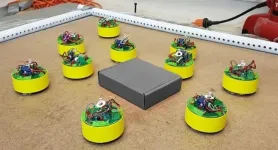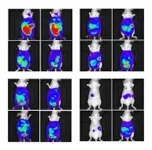How oxygen radicals protect against cancer
Goethe University researchers investigate oxidative stress in mice
2021-04-23
(Press-News.org) FRANKFURT. Originally, oxygen radicals - reactive oxygen species, or ROS for short - were considered to be exclusively harmful in the body. They are produced, for example, by smoking or UV radiation. Because of their high reactivity, they can damage many important molecules in cells, including the hereditary molecule DNA. As a result, there is a risk of inflammatory reactions and the degeneration of affected cells into cancer cells.
Because of their damaging effect, however, ROS are also deliberately produced by the body, for example by immune or lung epithelial cells, which destroy invading bacteria and viruses with ROS. This requires relatively high ROS concentrations. In low concentrations, on the other hand, ROS play an important role as signalling molecules. For these tasks, ROS are specifically produced by a whole group of enzymes. One representative of this group of enzymes is Nox4, which continuously produces small amounts of H2O2. Nox4 is found in almost all body cells, where its product H2O2 maintains a large number of specialised signaling functions, contributing, for example, to the inhibition of inflammatory reactions.
Researchers at Goethe University Frankfurt, led by Professor Katrin Schröder, have now discovered that by producing H2O2, Nox4 can even prevent the development of cancer. They examined mice that were unable to produce Nox4 due to a genetic modification. When these mice were exposed to a carcinogenic environmental toxin (cancerogen), the probability that they would develop a tumour doubled. Since the mice suffered from very different types of tumours such as skin sarcomas and colon carcinomas, the researchers suspected that Nox4 has a fundamental influence on cellular health.
Molecular investigations showed that the H2O2 formed by Nox4 keeps a cascade going that prevents certain important signalling proteins (phosphatases) from entering the cell nucleus. If Nox4 and consequently H2O2 are absent, those signalling proteins migrate into the cell nucleus and as a consequence, severe DNA damage is hardly recognised.
Severe DNA damage - e.g. double strand breaks - occurs somewhere in the body every day. Cells react very sensitively to such DNA damage, setting a whole repertoire of repair enzymes in motion. If this does not help, the cell activates its cell death programme - a precautionary measure of the body against cancer. When such damage goes unrecognised, as occurs in the absence of Nox4, it spurs cancer formation.
Prof. Katrin Schröder explains the research results: "If Nox4 is missing and there is therefore no H2O2, the cells no longer recognise DNA damage. Mutations accumulate and damaged cells continue to multiply. If an environmental toxin is added that massively damages the DNA, the damage is no longer recognised and repaired. The affected cells are not eliminated either, but multiply, sometimes very quickly and uncontrollably, which eventually leads to the development of tumours. A small amount of H2O2 thus maintains an internal balance in the cell that protects the cells from degeneration."
INFORMATION:
ELSE PRESS RELEASES FROM THIS DATE:
2021-04-23
Copper remains one of the single most ubiquitous metals in everyday life. As a conductor of heat and electricity, it is utilized in wires, roofing and plumbing, as well as a catalyst for petrochemical plants, solar and electrical conductors and for a wide range of energy related applications. Subsequently, any method to harvest more of the valuable commodity proves a useful endeavor.
Debora Rodrigues, Ezekiel Cullen Professor of Engineering at the University of Houston Cullen College of Engineering, in collaboration with Francisco C. Robles Hernandez, ...
2021-04-23
Anyone with children knows that while controlling one child can be hard, controlling many at once can be nearly impossible. Getting swarms of robots to work collectively can be equally challenging, unless researchers carefully choreograph their interactions -- like planes in formation -- using increasingly sophisticated components and algorithms. But what can be reliably accomplished when the robots on hand are simple, inconsistent, and lack sophisticated programming for coordinated behavior?
A team of researchers led by Dana Randall, ADVANCE Professor of Computing and Daniel Goldman, Dunn Family Professor of Physics, both at Georgia Institute of Technology, sought to show that ...
2021-04-23
Smoking is the leading cause of preventable death in America and causes about 30% of all cancer deaths. That's why researchers with the UC Davis Comprehensive Cancer Center wanted to study the impact of a California law passed in 2016 that raised the tobacco sales age from 18 to 21. Their new study published in Preventive Medicine examines smoking behavior after the state implemented one of the first tobacco 21 (T21) policies.
The study, conducted by UC Davis researchers Melanie Dove, Susan Stewart and Elisa Tong, looked at smoking patterns before and after the law passed and compared California and other states without a T21 policy. The data was from the 2012-2019 Behavioral Risk Factor Surveillance System.
"Most adult tobacco users start smoking ...
2021-04-23
Batteries are a part of everyday modern life, powering everything from laptops, phones and robot vacuums to hearing aids, pacemakers and even electric cars. But these batteries potentially pose safety and environmental risks.
In a study recently published in Cell Reports Physical Science, researchers at Texas A&M University investigated the components of a different kind of battery -- a metal-free, water-based battery -- which would reduce the flammable nature of standard batteries and decrease the number of metal elements used in their production.
Most batteries are ...
2021-04-23
Researchers led by Katsunori Tanaka and Kenward Vong at the RIKEN Cluster for Pioneering Research (CPR) in Japan have demonstrated that tumor growth can be reduced by therapy that tags cancer cells with different therapeutic molecules. In one case, the group was able to prevent tumors from forming in mice by targeting cancer cells with a compound that makes it difficult for the cells to clump together and form tumors. For tumors that already existed, they targeted cancer cells with toxic compounds that destroyed them. This study was published on April 23 in Science Advances.
One of the major problems with current cancer treatments is that their effects are not limited to cancerous cells in ...
2021-04-23
An international team of researchers led by the University of Bergen has uncovered how organisms from crops to corals may avoid deadly DNA damage during evolution.
Our cells, and those of animals, plants and fungi, contain compartments that produce chemical fuel. These compartments contain their own DNA, which stores instructions for important cellular machinery. But this so-called oDNA (organelle DNA) can become mutated, corrupting the instructions and preventing cells making enough energy.
In humans and some other animals, a process called the "bottleneck" allows some offspring to inherit less mutated oDNA. This process needs mothers' egg cells to develop early, like in humans, where a human girl is born with all ...
2021-04-23
DURHAM, N.C. - Fruits and veggies are good for you and if you are a lemur, they may even help mitigate the effects of habitat loss.
A new study sequencing the genome of four species of sifakas, a genus of lemurs found only in Madagascar's forests, reveals that these animals' taste for leaves runs all the way to their genes, which are also more diverse than expected for an endangered species.
Sifakas are folivores, meaning that the bulk of their diet is composed of leaves. Leaves can be difficult to digest and full of toxic compounds meant to prevent them from being eaten. Unlike our carefully selected spinach, tree leaves also don't taste great, and are not very nutritious.
Because of that, leaf-eaters ...
2021-04-23
Strenuous efforts to prevent and treat malaria in recent decades have brought great benefits, particularly against disease caused by Plasmodium falciparum in countries in Africa and the Americas. But malaria caused by its "stealthier and more resilient cousin", P. vivax, now needs to be confronted with high priority, say Lorenz von Seidlein and Nicholas White of the Mahidol Oxford Tropical Medicine Research Unit in Bangkok, Thailand in a Perspective. The piece introduces a Collection on the prevention and treatment of P. vivax malaria in the open access journal PLOS Medicine, published ahead of World Malaria Day on April 25th.
In a Review article in the Collection, Sarah Auburn of the Menzies School of Health Research and Charles Darwin University, Darwin, Australia ...
2021-04-23
Extremist perpetrators of violence often quote verses from their religion's holy scriptures that authorize, or even prescribe, attacks on enemies of the faith. Abdullah H., the Syrian now on trial who stabbed a homosexual couple with a knife and killed a man in Dresden in October 2020, also testified that he had been inspired to commit the crime by a Quranic sura. However, whether the religious motivation that extremist perpetrators of violence emphasize is causally related to their actions is often doubted. Now, WZB researchers Ruud Koopmans and Eylem Kanol can prove for the first time that verses in religious scriptures that legitimize violence can increase support for killing enemies of the faith.
Together with Dietlind Stolle, a German-Canadian ...
2021-04-23
In a rare exchange, scientists and water resources engineers from Iran and Utah are collaborating on a bold scientific study to restore one of the world's largest saline lakes.
Lake Urmia -- a massive salt lake in Iran's northwest and a sister to Utah's Great Salt Lake -- has lost nearly 95 percent of its volume over the last two decades. As water levels drop, salinity spikes, threatening the lake's brine shrimp population and the flamingos and other bird species that depend on the shrimp for food. Lake levels are so low that at some coastal resorts, tourism boats must be pulled a kilometer (0.6 mile) or more from shore by tractor before reaching suitable depths. In addition, new land bridges are forming in the drying lake bed which allows mainland predators ...
LAST 30 PRESS RELEASES:
[Press-News.org] How oxygen radicals protect against cancer
Goethe University researchers investigate oxidative stress in mice






